



The6 pilots and supprt personnel of 896 squadron assembled at RNAS Stretton on August 15th 1942 and from there took passage to America in the fast troop ship QUEEN MARY. The squadron officially formed at US Naval Air Station (USNAS) Norfolk, Virginia on September 15th as a single seat fighter squadron equipped with six Martlet IV aircraft,[1] Lt. (A) S. G. Orr DSC RNVR in command.
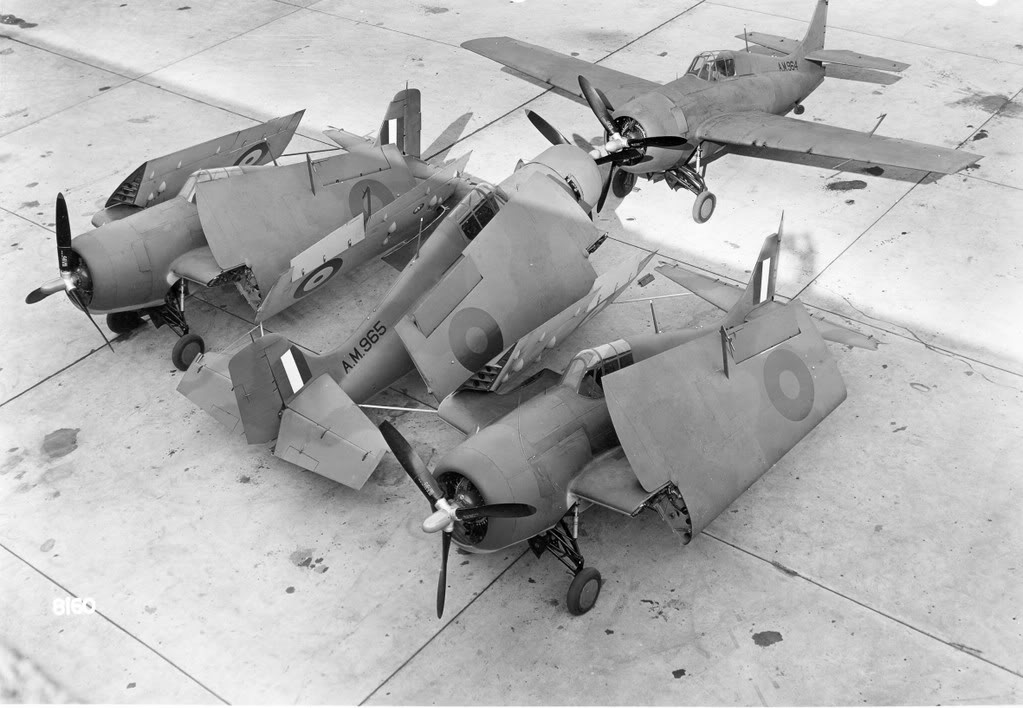
The Grumman Wildcat.
After
familiarisation with the aircraft and equipment the squadron moved
to USNAS
Quonset Point,
Rhode Island, on November 2nd to continue training. On January 6th
1943 they briefly returned to Norfolk for deck landing training
(DLT) in the training carrier USS
CHARGER. Opportunity for DLT was taken whenever a suitable carrier was in the area, the CVE
ATTACKER obliged; obliged; she was visited by Martlet fighters from 882, 896 and
898 squadrons for DLT sessions prior to their embarking in the Fleet Carrier HMS VICTORIOUS at the start of February.
During this final period of training before embarking for active duty one aircraft was lost on January 13th; FN139 suffered an engine fire on take-off and hit a tree, the pilot Sub-Lt. J. W. Herbert RNVR was OK but the aircraft was burnt out.
The squadron embarked in HMS VICTORIOUS
on February 1st 1943, followed two days later by her sister Martlet
squadron, 898 which had also formed at
Norfolk and been working up
at
Quonset Point. The
ship also carried two other squadrons, 8 3 2, the first RN squadron
equipped with Avenger TBM mark 1, 12 of which were on loan from the
US Navy VICTORIOUS spent the next
two weeks working up before departing for the Panama Canal. Ten days
later one of 896 squadron pilots, Sub-Lt. R. C. E. Hutchinson RNVR, was
killed when he bailed out at too low a height after his aircraft
FN317 caught fire in the air; the aircraft crashed into the sea.
HMS VICTORIOUS was to be loaned to the
US Navy after an American plea for carrier reinforcement in the
south west Pacific; they had lost the USS HORNET and the USS ENTERPRISE was
badly damaged at the Battle of the Santa Cruz Islands, this left
only one fleet carrier, the USS SARATOGA, operational in the Pacific
in late December 1942. HMS VICTORIOUS took passage to Pearl Harbour,
Hawaii via the Panama Canal on February 14th, arriving there on
March 4th; her squadrons were flown ashore to the US NAS Pearl Harbour
while the ship entered the dockyard for alterations to allow for
correct operation of the American built Avenger and Wildcat aircraft
types. During this period damage incurred during the voyage was
repaired and additional close range armament was fitted including
additional sponsons outboard of the island structure.
Two more squadron aircraft had suffered damage on the voyage, FN280 landed to port, went over the edge, and caught fire on February 27th; Sub-Lt. D. R. Mackintosh RNZNVR was unhurt. On March 4th FN300 drifted on take-off, one of its wheels was torn off on a gun turret Sub-Lt. B. W. Nicholas RNZNVR was unhurt. Lt. Cdr (A) B. H. C. Nation RN assumed command of the squadron on March 28th 1943.
Operation 'TOENAIL' and 'CARTWHEEL': All squadrons
re-embarked in VICTORIOUS on May 7th 1943, she sailed the next day to begin exercises with US aircraft carrier the USS SARATOGA and US battleship NORTH CAROLINA. During her time on loan she was code
named (but not renamed) as USS Robin for signals purposes. On completion of this work-up for service with the US Navy she took passage
to join the US Third Fleet Task Group 36.3 for support of US landing operations. The ship arrival at the fleet anchorage at Noumea, New
Caledonia on May 17th and joined the carrier USS SARATOGA in Task Force 14 for sweeps through the Coral Sea and joint exercises and
operations. The two aircraft carriers had a mix of US and British squadrons, with air-cover provided by VICTORIOUS and strike aircraft
by SARATOGA. On May 21st Martlet FN300 suffered an engine
failure on take-off and dove into the sea, Midshipman R. C. Wilkinson
RNVR was recovered unhurt.
On returning to New
Caledonia her squadrons flew ashore to U.S. Army Air Force (USAAF)
Airfield at Tontouta on
June 13th. After a short stay they re-embarked on the 16th for a
short foray to sea, disembarking to Tontouta on the 20th. While at
the Noumea Fleet anchorage on June 22nd, another squadron member was
killed in a flying accident; Lt. Cdr H. W. Metcalfe RNVR died when his
aircraft, FN271, dived into the sea, inverted after attempting an
upward roll ahead of the ship, it broke up and sank.
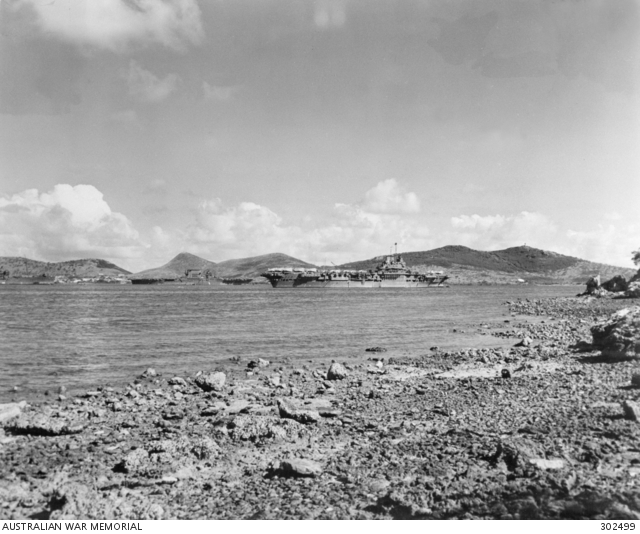
Noumea, New Caledonia. 1943. The aircraft carriers USS SARATOGA (left) and HMS VICTORIOUS (right) at anchor. Wildcat fighters and Avenger torpedo bombers are ranged on the victorious' flight deck. (Australian War Memorial - Naval historical collection 302499)
896 next embarked on June 27th, this
time for the ship's deployment with USS SARATOGA and TG63.3
in operation 'TOENAILS' the Munda landings on the island of New
Georgia in the Western Province of the Solomon Islands, which
began on June 30th, and operation 'CARTWHEEL' the larger overarching
plan for invading the Islands by US Marines in the Middle Solomons.
On completion of Operation 'TOENAILS'
VICTORIOUS returned to Noumea on July 25th, disembarking aircraft to
USAAF Tontouta for a final 7 day spell ashore before sailing for a
second deployment with Task Group 63.3 on the 31st, this time in
support of the Bougainville invasion. The only notable incident
during this period was the loss of Martlet FN221 which went over the
starboard side landing on VICTORIOUS on July 13th, the pilot Sub-Lt.
L J.B. Madden RNVR was recovered unhurt.
On release from
operations in the Pacific HMS VICTORIOUS sailed for the US Naval
Operating Base at Norfolk, calling at San Diego,
California before transiting the Panama Canal. On arrival at Norfolk
the squadron disembarked to USNAS
Norfolk
on September 1st,
moving to USNAS Willow Grove, Pennsylvania the next day to re-equip
with new Wildcat Mk.Vs, its strength being increase to 10 aircraft.
The squadron returned to
Norfolk on the 11th, and
re-embarked in VICTORIOUS on the 16th to return to the UK.
HMS VICTORIOUS sailed for the first leg of her passage to the UK on the 17th arriving at Argentia, Nova Scotia, on the 19th; after an overnight layover she continued escorted by OPPORTUNE, OBDURATE, and CALDE. On her arrival off the Irish coast on the September 26th 896 & 898 squadrons flew ashore to RNAS Eglinton, Northern Ireland, ending their time VICTORIOUS. At Eglinton 896 began training and working-up in preparation for joining their next ship HMS PURSUER.
After familiarisation and a short work-up with the new aircraft the squadron moved to RNAS Stretton on September 20th for further flying training. On October 30th 896 squadron became part of No.7 naval Fighter Wing, comprised of six squadrons; two Hellcat squadrons 800 and 804 for service in the assault carrier EMPEROR, and four Wildcat squadrons for service on fighter carriers, 881 and 896 for service in PURSUER and 882 and 898 for service in SEARCHER.
At this time HMS PURSUER was a newly arrived escort carrier which was in dockyard hands in Liverpool undergoing modification work. Lt. Cdr (A) L. A. Hordern DSC RNVR took over as commanding officer on October 25th 1943. A detachment of 4 aircraft went to RNAS Ayr on October 27th returning on November 6th. There were two flying incidents during this training and work-up period at Eglinton, both involved Wildcat JV413; on November 11th while flown by Sub-Lt. L .V. H. Martin RNZNVR the aircraft ran off the taxiway into soft ground and tipped on its nose. On November 19th the aircraft crashed in Lough Foyle, during a low formation flight over water in bad weather, the pilot Sub-Lt. J. H. Nurse RNZNVR was killed.
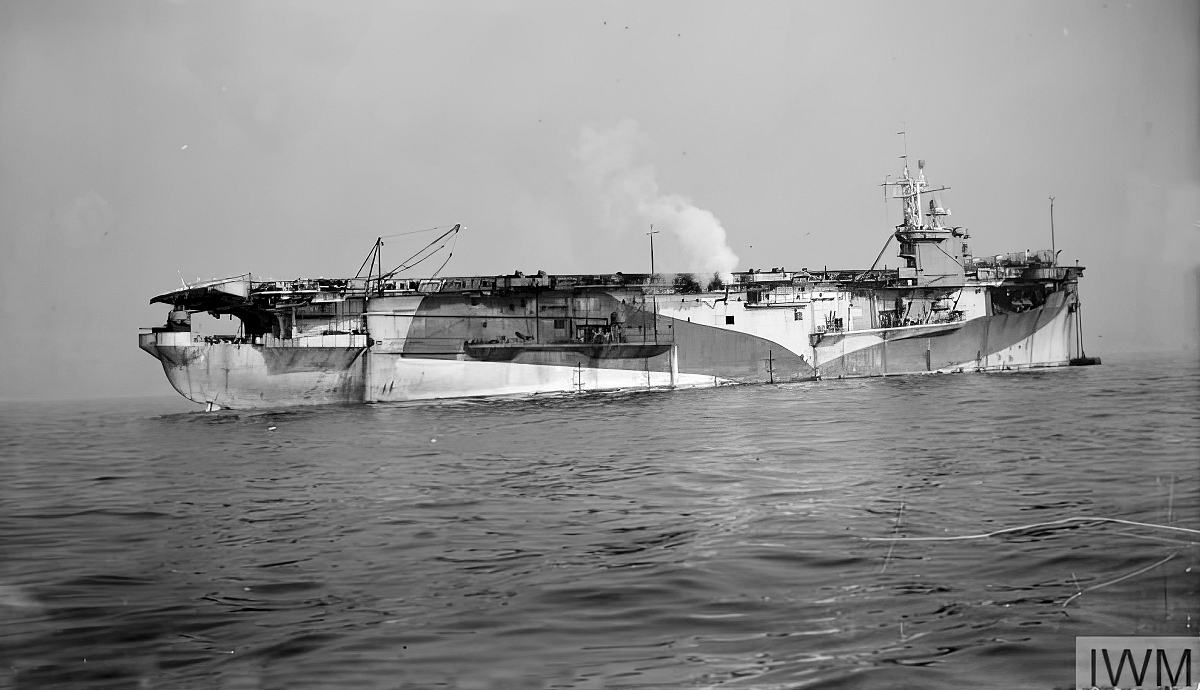
HMS PURSUER at Greenock, March 6th 1944. A number of Wildcat fighters can be seen parked on the front of the flight deck. © IWM A 22179
The American built Escort Carrier
PURSUER was outfitted a fighter carrier and was to operate two Wildcat squadrons,
881 and
896
each with 10 aircraft. On November 26th
PURSUER sailed from the Clyde for Belfast to embark aircraft and undergo repairs.
At this time
881 squadron was at
RNAS Belfast
while
896 squadron was at
RNAS Eglinton.
881
embarked first on the 26th the ship anchored in Belfast Loch
at 16:30. She put to sea at 08:35 the following day and
embarked the aircraft of 896 squadron, returning to her
anchorage at 17:40. Lt. Cdr (A) D. R. B. Cosh RCNVR took
over as commanding officer of 896 on November 27th.
PURSUER
put to sea at 08:35 on the 28th, returning at 17:40 the
following day; it is assumed this was for flying operations.
She then underwent repair work which was completed on
December 19th when she sailed to begin her work-up in the
Irish Sea.
The work-up period began with a tragedy on the first day when Sub-Lt D. C. Newman, RNVR (881) squadron was killed; he was flying in Wildcat JV387 when he was waved off by the DLCO (Deck Landing Control officer) to go around again, his starboard wing tip touched a wireless mast and the aircraft spun into the sea and sank. A second of 881 squadron’s aircraft was badly damaged on the 20th when Sub-Lt A. A. Davison, RNZNVR flying JV375 had a barrier crash. There was one other flying accident recorded during the work-up period Wildcat JV369 ('SC'), (881), suffered an undercarriage collapse landing on January 10th 1944; the pilot Sub-Lt D. L. W. Frearson, RNVR was OK. 896 Sqn appears to have had an incident free work-up period.
On completion of her work-up
PURSUER was allocated for deployment in Western Approaches for convoy defence duties and sailed with the 16th Escort Group (16 EG)
on February 4th 1944. Between February 6th and 15th she provided
air patrols over convoy OS.67/ KMS.41 (Liverpool to
Gibraltar/Freetown). On February 8th Lt. A. C. Martin, RNZNVR (896) flew JV409 into the barrier.
The convoy came under attack 0n the 12th. In the morning at 09:45 the squadron C.O. of 881 Lt- Cdr Cosh in JV392 ('2H') intercepted what was reported to be a Ju290. That evening after dusk, an attack formed of seven He-177s from II.KG-40 carrying the Henshel Hs-293 glide bombs approached the convoy. Two flights of Wildcats from 881 engaged them; at 19:30 Lt. Wilson and Sub Lt. Brander engaged the group and Sub Lt. Brander in JV429 ('2N') claimed one He-177 shot down and blew up. At 20:00 the squadron CO Lt- Cdr Cosh in JV375 ('2V’) and his wingman Sub-Lt Turner engaged what they presumed to be 4 or 5 He-177 and probably two Fw200 recon planes. They claimed one Fw200 destroyed and one possibly damaged.
On February 16th the Convoy split; OS.67 continuing on to Freetown, while KMS.41 further split into KMS.41G going to Gibraltar, with the main convoy bound for Port Said. Also on the 16th one of
881 squadrons Wildcats was diverted to land at
RN Air Section North Front, Gibraltar when its tail hook failed to unlock for landing on the carrier. The Gibraltar section of KMS.41 arrived in port on the 17th.
On the 19th Sub-Lt. A. N. Pym, RNVR (896) made a barrier crash and overturned in JV435. PURSUER and 16 EG prepared to rendezvous with the north bound SL.149 (Freetown to UK) /MKS.40 (Port Said to UK) which joined up on February 22nd. O the 26th Sub-Lt. D. Symons, RNVR (896) flying in JV421 suffered from falling fuel pressure and ditched, he was rescued by HMS SCARBOROUGH. On release from Atlantic convoy defence on March 6th PURSUER returned to the Clyde.
PURSUER was loaned to the Home Fleet for her next operation, sailing from the Clyde on March 17th in company with sister CVEs
EMPEROR,
FENCER,
and
SEARCHER, to participate in providing fighter escort for air attacks on the German battleship TIRPITZ (Operation TUNGSTEN). She arrived at Scapa Flow on the 18th. Flying training continued through the remainder of March.
Operation TUNGSTEN forces left Scapa on March 30th in two groups; Force 1 comprised DUKE OF YORK, ANSON, VICTORIOUS, BELFAST, and 5 destroyers left Scapa early morning and after conducting brief exercises proceeded to a position off Bear Island to cover the passage of convoy JW58. Force 2 comprised ROYALIST (Rear Admiral Escort Carriers),
EMPEROR,
FENCER,
PURSUER,
SEARCHER, FURIOUS, SHEFFIELD, JAMAICA, 2 oilers, and 5 destroyers left Scapa p.m. and preceded west of the Orkneys.
On April 1st, the date for the operation, which had been April 4th, was advanced 24 hours to take advantage of favourable weather and lack of air reconnaissance of Force 1. Force 1's first screen from Skaalefiord joined Force 2 the following day and on April 1st the two oilers with two destroyers were detached to the oiling position. On April, 2nd ANSON, VICTORIOUS, BELFAST, and 4 destroyers were detached from Force 1 and joined Force 2. The TUNGSTEN force then steered for the flying off position. Flying conditions were perfect when the flying off position was reached at 0400 on the 3rd and the aircraft were flown off according to plan except for the loss of one Barracuda which ditched. 40 Barracudas and 81 fighters took part in the two strikes and a further 25 fighters and 9 Swordfish were kept for the defence of the Fleet.
The good weather allowed for the two strike forces to obtain their desired heights and to take the best route over the mountains. No enemy aircraft were seen by the strike aircraft or the Fleet and the flak around the TIRPITZ was much less than anticipated. The attack was carried out by both fighters and bombers; fighters strafing the defences from a low height and bombers pressing home an accurate attack. The losses during the attack were remarkably small. One Barracuda was shot down over the target and another by shore batteries, both after dropping their bombs. A third Barracuda was lost taking off from VICTORIOUS and a Hellcat ditched when unable to land on EMPEROR. Both strikes returned and landed on safely with the exception of the one Hellcat. The question of repeating the attack the next day was considered but owing to fatigue of the air crews and serious damage reported to TIRPITZ this was abandoned and the force withdrew to the westward. After withdrawing to Scapa 896 squadron disembarked to RNAS Hatston, Orkney, on April 6th, 881 remaining on board. This was a short break before re-embarking on the 11th to prepare for Operation PITCHBOWL.
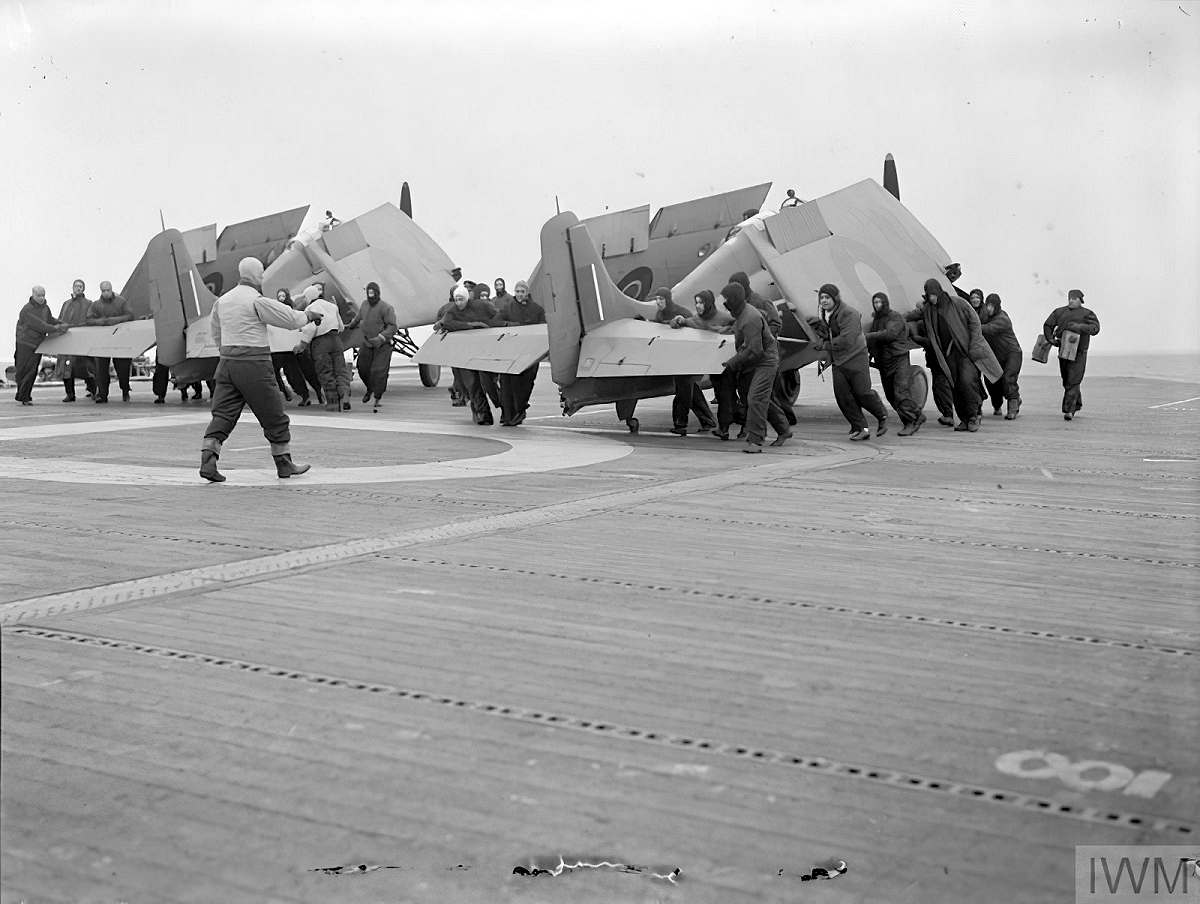
April 1944: Flight deck parties man-handle aircraft around the deck, the one on the right is being pushed onto the forward aircraft lift ready to be struck down into the hangar. Image © IWM A 23061.
Operation PITCHBOWL was to be a repeat of TUNGSTEN ; the force, ROYALIST (Rear Admiral Escort Carriers) with
EMPEROR,
FENCER,
PURSUER, BERWICK, SHEFFIELD, escorted by MUSKETEER, METEOR, MARNE, MATCHLESS, ONSLAUGHT, PIORUN, and SIOUX sailed on April 13th, but the operation was cancelled the next day due to bad weather and the force returned to Scapa.
Operation PLANET was the next attempt to strike at TIRPITZ, undertaken by two forces. Force 7 – Battleship ANSON (VA, 2.i.C. Home Fleet), Fleet Carriers VICTORIOUS and FURIOUS, Cruiser KENT, HM Destroyers KEMPENFELT (D26), KELVIN, SWIFT, VENUS, VIGILANT HM Canadian Destroyers ALGONQUIN, SIOUX. Force 8 -Cruisers ROYALIST (Rear Admiral Escort Carriers), JAMAICA, CVEs EMPEROR, PURSUER, SEARCHER, STRIKER, HM Destroyers JAVELIN, SERAPIS, UNDAUNTED, URSA, WAKEFUL, WIZARD, and Polish Destroyer ORP PIORUN,. Both Forces sailed from Scapa on Friday April 21st.
The attack was planned for April 24th and involved 40 Barracudas with 40 escort fighters; when the forces arrived in the area on the 23rd the weather forecasts were unsuitable and they reversed course for 48 hours. Weather on the following day was equally bad. Both forces proceeded to the flying off position but there was no improvement and the Vice Admiral, Second in Command, abandoned the operation and proceeded to carry out Operation RIDGE.
Operation RIDGE was originally intended to be carried out in two parts – RIDGE ABLE (Attack by Force 7 on the shipping in the Bodo area) and RIDGE BAKER attack by Force 8 on shipping in the Rorvik area). In the event it was decided that both forces should carry out RIDGE ABLE with two strikes, one attacking Bodo harbour and the other sweeping the leads to the southward. The two forces arrived at the flying off position at dawn on April 26th.
Weather conditions were not ideal and were worse inshore and in the end both strikes attacked the same target – an escorted convoy of 4 or 5 merchant ships in approximately 67°06’ N, 13°57’ E at about 06:00. The convoy was southbound, presumably having left Bodo about an hour previously. Four merchant ships and one escort vessel were claimed to have been hit with bombs. The largest merchant ship was reported beached and burning and two others on fire.
Two Barracudas and several fighters succeeded in penetrating Bodo Harbour in spite of the weather and one hit was obtained on a large merchant ship. Two other Barracuda bombed a derelict merchant ship ashore and obtained at least one hit. No German aircraft were seen; light but accurate flak was encountered, particularly at Bodo and the force lost 1 Barracuda, 2 Corsairs, 1 Hellcat, and 1 Wildcat. The Wildcat was from 881 Sqn, Sub-Lt Turner in JV373 ('S') failed to return after being hit be by flak over Arno Island, he ditched near a beach 25 yards off the northwest tip of Sandhorne Island and was taken prisoner.
The force arrived back at Scapa on the 28th, PURSUER being released from her detached duties she sailed on April 30th for Liverpool to undergo repairs. on reaching Liverpool Bay on May 1st both 881 and 896 squadron disembarked to RNAS Burscough, Lancashire.
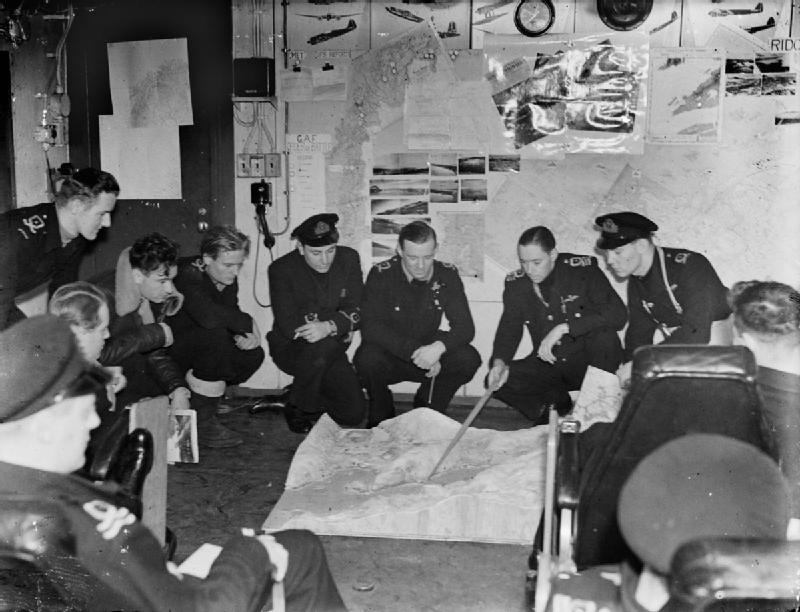
Fighter pilots in the briefing room of HMS PURSUER check over the details of their next operation with their Squadron Leader Lieutenant Commander L. A. Hordern, RNVR who is using a cane to point out particular features on a map. © IWM (A 23053)
PURSUER put to sea on June 2nd 1944 embarking both her squadrons from
RNAS Burscough to prepare for operations in the western approaches as part of the cover forces for NEPTUNE operations.
PURSUER was employed with
TRACKER
and
EMPEROR in a position 150 miles west of Lands’ End to carry out anti-submarine patrols to intercept U-Boat attempt to enter the English Channel for attacks on invasion traffic. The 1st, 2nd, 5th, 6th, 9th, 11th, 14th, and 15th Escort Groups were also deployed in this area to provide additional support.
On June 5th all available hands were employed to paint the aircraft with the black and white "Bumble Bee" recognition stripes that all allied aircraft were to wear for the invasion. On June 8th 896 squadron lost another pilot; Sub-Lt. J. M. Barber was killed when his aircraft, JV541 crashed into the sea after an accelerated take off.
There were few contacts to investigate during this operation but one enemy aircraft was intercepted and destroyed; at 18:35 on June 9th Lt A. C. Martin, RNZNVR and Sub-Lt. D. Symons, RNVR of 896 squadron attacked and shot down a Ju88 at 49°4'N 7°58'W. PURSUER was released from NEPTUNE operations on June 11th and on arriving back on the Clyde on the 12th was allocated for operations with the Mediterranean fleet.
A change of policy regarding the structure of the Naval Fighter Wings resulted in change to the number of squadrons embarked in the escort carriers; the two squadrons embarked in each carrier were to be combined to form a single 24 aircraft squadron, the other disbanded. On June 12th 1944 896 squadron was officially disbanded aboard PURSUER, her aircraft and aircrew being absorbed into 881 [2]
No.896 squadron was to reform as a single seat fighter squadron for service with the East Indies Fleet. Personnel for the new Squadron were assigned on October 25th 1944 and assembled at Liverpool on November 5th where they embarked in the troopship HMT FRANCONIA for passage to Port Said (probably joined the large trooping convoy KMF.36 which sailed from the Clyde on the 6th and the convoy arrived in Gibraltar on the 15th, reaching Port Said on the 20th.). On arrival they disembarked for a few weeks wait at Ismailia before travelling down to Port Tewfik to continue their passage to Durban. They embarked in the Polish Troopship KOSCIUSZKO and called at Aden, on December 14th, then Kilindini on the 22nd. After a two day stop-over they sailed again on the 24th, arriving at Durban on December 30th 1944. They finally arrived at Cape Town, on January 5th 1945, and the squadron officially formed at RNAS Wingfield on January 9th. Lt. Cdr (A) R. M. Norris RNVR in command. Their equipment was 24 Hellcat FB.IIs, mostly new machines, but some were previously operated by 804 squadron, which were issued by RN Aircraft Repair Yard Wingfield.
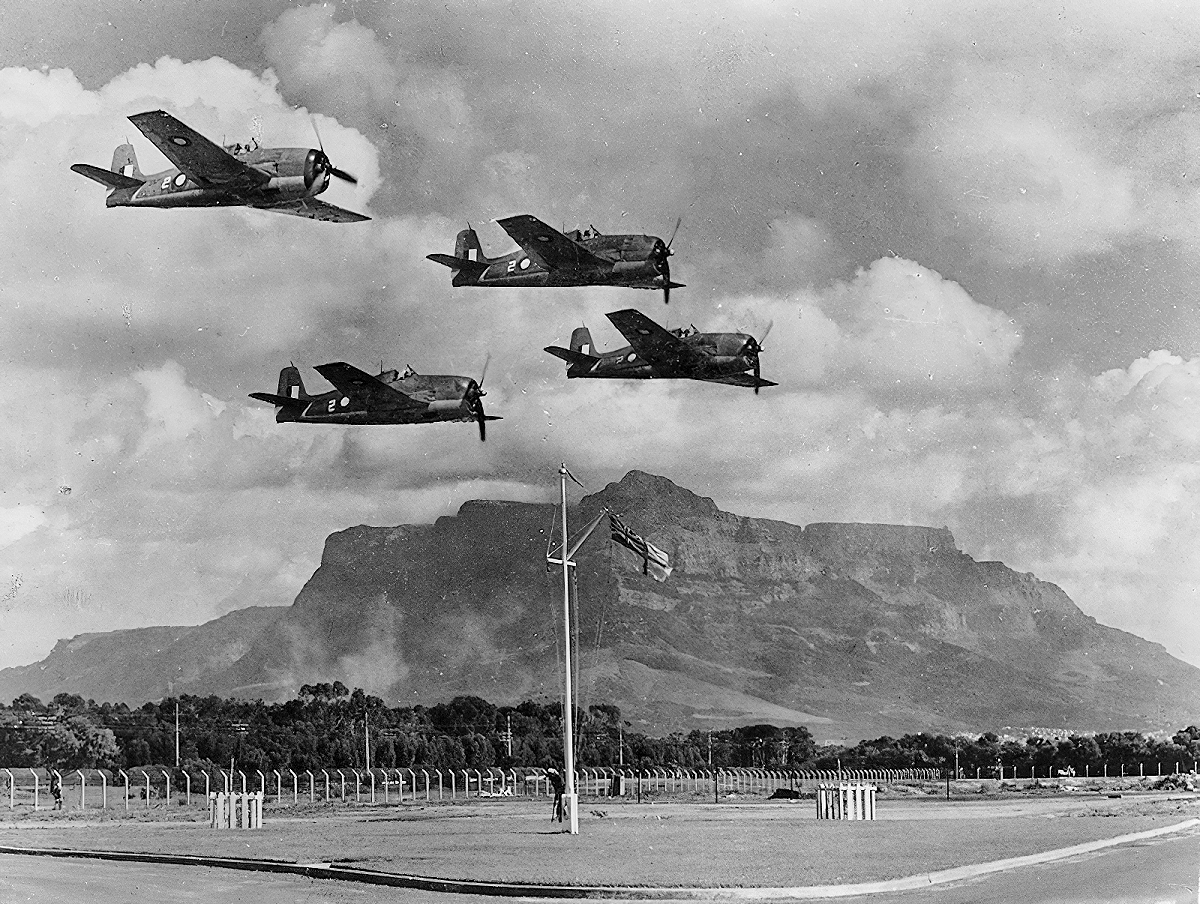
Hellcat FB.IIs fly past the quarter deck at RNAS Wingfield, HMS MALAGAS, Cape Town with Table mountain in the background.
The squadron spent the most of January getting familiarised with the Hellcat, and the area, both on the ground and in the air; for many of the young pilots this was their first front-line squadron, having only recently returned from flying training in America. At this time 896 Squadron had a strength of twenty four pilots including the CO and Senior Pilot, Lt Harry Palmer SANF(V) and two Air Liaison officers, Captain Dennis Sevenoaks and Major Phillip Mann.
The first three and a half months of
1945 were spent working up at
RNAS
Wingfield, conducting exercises
and armament practice in the Cape area. It is possible that some
members of the squadron were present on the station before the main
party arrived on January 5th - there is record of Hellcat JW709
being issued to 896 on January 3rd and crashing on the 5th; the
aircraft was being flown by Sub-Lt. F. C. Birch RNVR when it suffered an
engine failure while in the circuit and crashed into the bush near
the airfield, the pilot was OK. The work up period went relatively
smoothly with only four aircraft incidents; on January 23rd Lt. C. P. Stark
RNVR taxied into a stationary aircraft, on February 8th Sub-Lt.
B. E. Smart RNVR in Hellcat JX699 nosed over and overturned, while on the
18th Sub-Lt. R. C. Thompson RNVR ran JX688 into the tail of Sub-Lt. V. H. Seddon's aircraft, JX719, causing propeller damage to both
aircraft. On March 28th JX678, flown by Sub-Lt. W. J. M. St. C. Reid,
was hit by fragments of a practice rocket projectile casing during
range practice.
On April 22nd the whole squadron
departed for
R.N. Air Section
Stamford Hill,
Durban, via SAAF Port
Elizabeth, after flying a mass Formation over Cape Town to 'show
the flag'. From there they were to embark in the escort carrier
HMS AMEER, part of the 21st Aircraft Carrier Squadron of the
East Indies Fleet, for passage to India.
The airfield at Stamford Hill presented
new challenges for the arriving pilots, firstly they were arriving
after dark at a grass airstrip with a flare path laid out with
goose-neck paraffin flares, and secondly it was necessary to
approach in a right hand circuit - the opposite of that at
Wingfield. Only 18 aircraft arrived on time. 6 others remained at
SAAF Port Elizabeth as their clocks had been stolen; they were
further delayed by bad weather and did not arrive until three days
later.
AMEER was in harbour at Durban, having been in dockyard hands
for defect rectification and a boiler clean. The first 18 aircraft
were towed through the streets and hoisted on board from the
quayside on April 24th. From Durban the ship sailed for Madras,
Southern India, arriving there on May 12th, 896 then disembarked to
RNAS
Tambaram for a short, but intensive, training period; at the end
of July it made a round trip flight to
RNAS Trincomalee, Ceylon, and
arrived back on June 5th.
The squadron was now ready for operations with the East Indies fleet
and was allocated to operate from
the escort carrier
EMPRESS and flew out to join the ship on June 10th. On June
20th the squadron carried out a period of DLT on
HMS
EMPEROR. 896 remained aboard until the 24th when they
transferred toAMEER in preparation for the upcoming operation 'COLLIE'. The
pilots now had to learn the art of the accelerated (catapulted)
take-off, necessary for getting a fully armed Hellcat off the short
flight deck in the light winds of the Indian Ocean.
Operation 'COLLIE' : July 1945 This operation was in preparation for
Malayan coast landings and included screening operations for the 6th
Minesweeping Flotilla (Force 62, comprising of 9 minesweepers) during
the clearance of
mines in the approaches to the Malacca Straits and the bombardment of
Car Nicobar.
AMEER
was to operate as part of Force 61 which comprised of the
cruiser NIGERIA, CVEs
AMEER (896 squadron) and
EMPEROR (800 Squadron) with Destroyers ROEBUCK, ESKIMO and VIGILANT
as screen. The force sailed from Trincomalee on July 2nd; Force 62
carried out minesweeping operations between the 5th - 10th while
NIGERIA carried out 8 bombardments between the 5th - 9th. Hellcats
from
AMEER and
EMPEROR carried out air strikes against targets on Car Nicobar
and Nancowry.
Further air strikes were launched on the 11th when
AMEER
and
EMPEROR launched a total of 24 aircraft to attack airfields at
Kota Raja and Lho Nga in NW Sumatra. A single Japanese aircraft
approached and was shot down. Four Hellcats were lost on operation
'COLLIE' and two pilots were killed; Sub Lt. W Stewart RNVR was killed
when his aircraft Hellcat JX677 Swung to port on a dawn take off on
July 5th and dove into the sea, it sank immediately. The other
fatality was the 896 squadron C.O. Lt. Cdr R. M. Norris, his Hellcat
JX680 was hit by flak during an abortive shipping strike at Nancowry on July 7th, and dove into the sea on fire.
Force 61 withdrew and returned to Trincomalee on July 14th. HMS AMEER arrived back at Ceylon on the 16th and 896 squadron was disembarked to Royal Naval Air Station Trincomalee where a new CO, Lt. Cdr (A) G. J. Zegers de Beijl DSC RNethN and five new pilots awaited to bring the squadron up to a strength of 27 pilots. The squadron next embarked aboard EMPRESS for Operation 'LIVERY', flying out to join the ship the following day
Operation 'LIVERY': July 1945 AMEER was deployed with Force 63 for operation LIVERY on July 19th; the force comprised of the Battleship NELSON, cruiser SUSSEX, and CVEs EMPRESS and AMEER with Destroyers PALADIN, ROTHERHAM, RACEHORSE and RAIDER to cover minesweeping operations carried out by HM Minesweepers PLUCKY, PINCHER, VESTAL RIFLEMAN and HM Indian Minesweepers PUNJAB and DECCAN off Phuket Island and conduct strikes on targets in northern Malaya. The operation began on the 24th and was to last for three days. This was an intense flying period for the two CVEs, over a 3 day period Hellcats from both carriers flew over 150 sorties and destroyed more than 30 Japanese aircraft on the ground, together with trains and road transport in attacks on the Kra Isthmus. Operation LIVERY was the last offensive operation carried out by the East Indies Fleet in WW2, two minesweepers were sunk during the operation: the remaining ships of Force 63 returned to Trincomalee on the 28th. Once back at Ceylon 896 Squadron disembarked to RNAS Trincomalee on July 30th to continue training, moving briefly to RNAS Puttalam in N.W. Ceylon before moving back to Trincomalee o August n 8th ready for re-embarkation in EMPRESS.
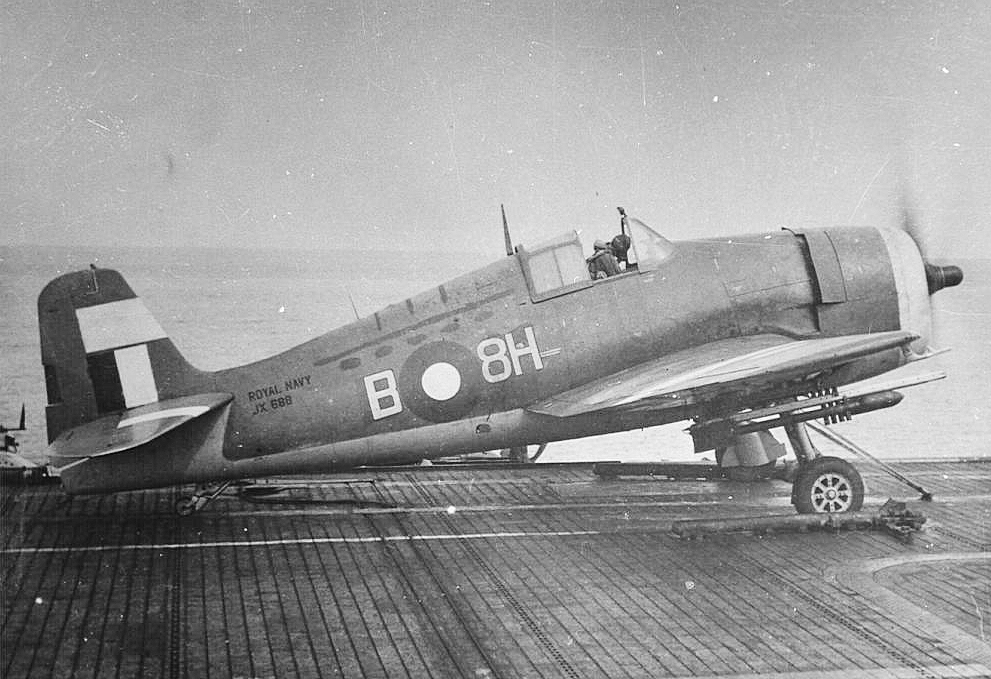
Hellcat JX688 'B8H' running up to full power in preparation for an accelerated launch. The aircraft is armed with rocket projectiles which are visible under the wings. The catapult towing strop can be clearly seen under tension, and the main wheels are aligned within the the guide cleats.
Operation 'CARSON': August 1945 This operation was a series of attacks on shipping and airfields in Penang and Medan area of Sumatra. Force 61, consisting of the AA Cruiser ROYALIST (Flag of Rear Admiral G.N. Oliver, CB, DSO, Rear Admiral Commanding 21ACS), CVEs AMEER , ATTACKER, EMPEROR, EMPRESS, KHEDIVE, and SHAH, Destroyers TARTAR (Captain (D), Tenth Destroyer Flotilla), PENN, VIGILANT, and VERULAM. The force sailed from Trincomalee on August 10th, to carry out strikes on August 14th and 15th. On August 11th the force was ordered to hold west of 90 degrees east and await further orders; the operation was eventually cancelled in light of the news of Japan's announced willingness to accept the Allies' surrender terms. The force subsequently returned to Trincomalee, arriving on August 15th when the Station General Message "SUSPEND OFFENSIVE OPERATIONS AGAINST JAPANESE FORCES" was made to all ships and allied forces.
Force 61 returned to Trincomalee, and after the V-J celebrations part of the squadron was disembarked to Royal Naval Air Station Katukurunda, a detachment remained aboard EMPRESS and continued flying operations throughout August, the squadron suffering two more accidents towards the end of the month; JX724 skidded into a walkway on the 23rd and JX706 burst a tyre landing on the 29th.
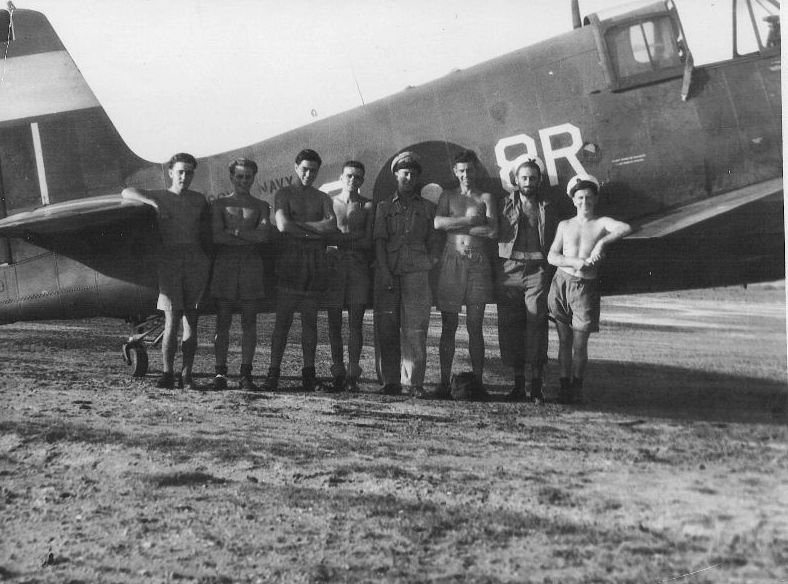
Hellcat 'B8R' with some of the squadron maintainers ashore. Date and location not known.
Operation 'ZIPPER': September 1945 At the start of September EMPRESS together with sister CVEs AMEER, EMPEROR, HUNTER, KHEDIVE, and STALKER were tasked with the reoccupation of Singapore, code name operation ZIPPER. EMPRESS embarked replacement aircraft before sailing with the force which left Trincomalee on the 4th. The replenishment went badly as the first of the Hellcats to fly out to the ship had to be waved off by EMPRESS'S Deck Landing Control Officer (DLCO) and it had to wait until the second one had landed safely; on his second attempt Sub Lt. R.W. George RNVR came in to high but ignored the DLCO signals and attempted a landing anyway. He cut his engine but passed over all the arrestor wires, and the barriers to drop onto several airframes in the forward aircraft park. More replacements had to be organised before she could proceed to join the task force.
Force 61 arrived off Singapore Island on September 6th and waited for instructions; on the 8th one of 896 squadrons hellcats, JX679 ditched alongside. EMPRESS, EMPEROR, HUNTER, KHEDIVE and STALKER anchored in Keppel Harbour, Singapore while AMEER and EMPRESS were among 90 ships (including 70 RN and RIN warships, 3 Royal Fleet Auxiliaries, 3 hospital ships and 14 merchant vessels) present in Singapore Roads for the surrender ceremony which took place on the 12th. EMPRESS returned to Trincomalee on September 13th flying off the aircraft of 896 Squadron for the last time to RNAS Katukurunda.
Ashore at RNAS Katukurunda the Squadron did little flying, their future was uncertain and personnel changes began. A new CO, Lt. Cdr (A) M. F. Turner RNVR, arrived on October 12th and several pilots returned home under the early release scheme; amongst these was the senior pilot Lt. H. A. T. Palmer SANF(V), he was replaced by Lt (A) J. E. Bullen RNVR.
The aircrew and maintenance personnel of 896 squadron embarked in EMPRESS on November 27th as passengers for passage home to the UK, their aircraft remained ashore at RNAS Katukurunda. EMPRESS left Colombo on November 27th calling at Bombay, Aden, Malta and Gibraltar, and arrived alongside at the King George V dock, Glasgow on December 19, 1945; the squadron was officially disbanded on this date.
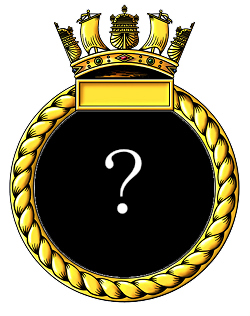
NORMANDY 1944
ATLANTIC 1944
NORMANDY 1944
BURMA1945
Martlet IV Sep 42 - Sep 43
Wildcat V Sep 43 - Jun 44
Hellcat II.FB Jan 45 - Nov 45
Sea King HAS.2 Sep 1978
Lt. (A) S. G. Orr DSC RNVR 15 Sep 1942
Lt. Cdr (A) B. H. C. Nation RN 28 Mar 1943
Lt. Cdr (A) L. A. Hordern DSC RNVR
25 Oct 1943
Squadron disbanded 12 Jun 1944
Lt. Cdr (A) R. M. Norris RNVR 9 Jan 1945
Lt. Cdr (A) G. 1 Zegers de Beijl DSC RNethN 14 Jul 1945
Lt. Cdr (A) M. F. Turner RNVR 12 Oct 1945
Squadron disbanded 19 Dec 1945
None
© 1999-2025 The Royal Navy Research Archive All Rights Reserved Terms of use Powered byW3.CSS
Press F5 to refresh the page after posting your comment or to hide the form
The first American built aircraft to enter RN service were the Grumman Avenger and Wildcat but the Admiralty changed their names to Tarpon and Martlet respectively. The name 'Tarpon’ was used for the Avenger Mk I and II, while ‘Martlet’ was used for Wildcat Mk I to IV; from January 1944 the Admiralty reverted to use the American names of Avenger from Mk III and Wildcat from Mk V to avoid confusion.
Close800 absorbed 804 in EMPEROR, and 882 absorbed 898 in SEARCHER, leaving only three squadrons, but the same total number of aircraft in the Wing.
Close
Comments (0)